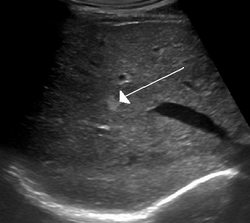Cavernous liver hemangioma

Editor-In-Chief: Prab R Tumpati, MD
Obesity, Sleep & Internal medicine
Founder, WikiMD Wellnesspedia &
W8MD medical weight loss NYC and sleep center NYC
| Cavernous liver hemangioma | |
|---|---|

| |
| Synonyms | Hepatic hemangioma, hepatic venous malformation |
| Pronounce | N/A |
| Specialty | N/A |
| Symptoms | Often asymptomatic, but may include abdominal pain, nausea, vomiting |
| Complications | Rarely, rupture, hemorrhage, Kasabach-Merritt syndrome |
| Onset | Any age, often detected in adults |
| Duration | Lifelong |
| Types | N/A |
| Causes | Congenital vascular malformation |
| Risks | Female gender, oral contraceptive use, pregnancy |
| Diagnosis | Ultrasound, CT scan, MRI |
| Differential diagnosis | Hepatocellular carcinoma, focal nodular hyperplasia, metastasis |
| Prevention | N/A |
| Treatment | Usually none required, surgery if symptomatic |
| Medication | N/A |
| Prognosis | Excellent, benign condition |
| Frequency | Common, estimated in up to 7% of the population |
| Deaths | N/A |
A benign liver tumor
Cavernous Liver Hemangioma[edit]

A cavernous liver hemangioma is a benign tumor of the liver composed of clusters of blood-filled cavities. It is the most common type of benign liver tumor and is often discovered incidentally during imaging studies for other conditions.
Pathophysiology[edit]
Cavernous liver hemangiomas are composed of large, dilated blood vessels. These vascular spaces are lined by a single layer of endothelial cells and are supported by a thin layer of fibrous tissue. The exact cause of cavernous liver hemangiomas is not well understood, but they are thought to be congenital in nature, arising from a malformation of blood vessels during embryonic development.
Clinical Presentation[edit]
Most individuals with cavernous liver hemangiomas are asymptomatic and the condition is often discovered incidentally. However, in some cases, patients may experience symptoms such as abdominal pain, nausea, or a feeling of fullness. Large hemangiomas can occasionally cause complications such as hemorrhage or thrombosis.
Diagnosis[edit]
Cavernous liver hemangiomas are typically diagnosed using imaging techniques such as ultrasound, computed tomography (CT), or magnetic resonance imaging (MRI). These imaging modalities can reveal the characteristic appearance of hemangiomas, which often appear as well-defined, hyperechoic lesions on ultrasound or as hypervascular lesions on CT and MRI.
Management[edit]
In most cases, no treatment is necessary for cavernous liver hemangiomas, especially if they are asymptomatic. Regular monitoring with imaging may be recommended to ensure that the hemangioma does not grow or cause complications. In rare cases where the hemangioma is large or symptomatic, surgical intervention such as hepatectomy or embolization may be considered.
Prognosis[edit]
The prognosis for individuals with cavernous liver hemangiomas is generally excellent, as these tumors are benign and do not have malignant potential. Most patients live normal lives without any impact from the hemangioma.
See also[edit]
Ad. Transform your life with W8MD's Budget GLP-1 injections from $75


W8MD offers a medical weight loss program to lose weight in Philadelphia. Our physician-supervised medical weight loss provides:
- Weight loss injections in NYC (generic and brand names):
- Zepbound / Mounjaro, Wegovy / Ozempic, Saxenda
- Most insurances accepted or discounted self-pay rates. We will obtain insurance prior authorizations if needed.
- Generic GLP1 weight loss injections from $75 for the starting dose.
- Also offer prescription weight loss medications including Phentermine, Qsymia, Diethylpropion, Contrave etc.
NYC weight loss doctor appointmentsNYC weight loss doctor appointments
Start your NYC weight loss journey today at our NYC medical weight loss and Philadelphia medical weight loss clinics.
- Call 718-946-5500 to lose weight in NYC or for medical weight loss in Philadelphia 215-676-2334.
- Tags:NYC medical weight loss, Philadelphia lose weight Zepbound NYC, Budget GLP1 weight loss injections, Wegovy Philadelphia, Wegovy NYC, Philadelphia medical weight loss, Brookly weight loss and Wegovy NYC
|
WikiMD's Wellness Encyclopedia |
| Let Food Be Thy Medicine Medicine Thy Food - Hippocrates |
Medical Disclaimer: WikiMD is not a substitute for professional medical advice. The information on WikiMD is provided as an information resource only, may be incorrect, outdated or misleading, and is not to be used or relied on for any diagnostic or treatment purposes. Please consult your health care provider before making any healthcare decisions or for guidance about a specific medical condition. WikiMD expressly disclaims responsibility, and shall have no liability, for any damages, loss, injury, or liability whatsoever suffered as a result of your reliance on the information contained in this site. By visiting this site you agree to the foregoing terms and conditions, which may from time to time be changed or supplemented by WikiMD. If you do not agree to the foregoing terms and conditions, you should not enter or use this site. See full disclaimer.
Credits:Most images are courtesy of Wikimedia commons, and templates, categories Wikipedia, licensed under CC BY SA or similar.
Translate this page: - East Asian
中文,
日本,
한국어,
South Asian
हिन्दी,
தமிழ்,
తెలుగు,
Urdu,
ಕನ್ನಡ,
Southeast Asian
Indonesian,
Vietnamese,
Thai,
မြန်မာဘာသာ,
বাংলা
European
español,
Deutsch,
français,
Greek,
português do Brasil,
polski,
română,
русский,
Nederlands,
norsk,
svenska,
suomi,
Italian
Middle Eastern & African
عربى,
Turkish,
Persian,
Hebrew,
Afrikaans,
isiZulu,
Kiswahili,
Other
Bulgarian,
Hungarian,
Czech,
Swedish,
മലയാളം,
मराठी,
ਪੰਜਾਬੀ,
ગુજરાતી,
Portuguese,
Ukrainian